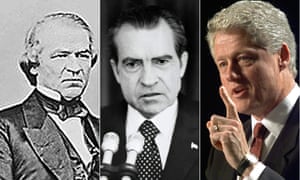Trump is on the precipice of becoming the third president in US history to be impeached – with one near-miss

Donald Trump is on the precipice of becoming the third president in US history to be impeached. It’s an exclusive club that no one wants to join – but who else is in it, and why?
Here’s a look back at the two prior impeachments and a third near-miss case.
Impeachment #1: Andrew Johnson (1868)
The assassination of Abraham Lincoln in April 1865 unexpectedly elevated his vice-president, Johnson, an outspoken white supremacist but strong anti-secessionist, to the White House. With the aftershocks of the civil war manifesting in bloody voter suppression and racially motivated terrorism across the South, Johnson’s presidency was immediately thrown into tumult by demands that the new president take steps to cement the war’s promise of racial equality. But Johnson vetoed civil rights legislation, unilaterally pardoned hundreds of former Confederate leaders and called for the murder of his political enemies.
Johnson was in essence impeached for undermining the cause of racial equality, the historian Brenda Wineapple wrote in her book The Impeachers.
But the bulk of the impeachment clauses against him were predicated on a relatively narrow charge of violating a contemporary “tenure of office” law (repealed soon thereafter) by removing his secretary of war, Edwin Stanton, who was instrumental in opposing racist attacks on suffrage for former slaves.
Johnson remained in office after being acquitted in the Senate by one vote – a bribed victory, historians have speculated.
Impeachment #2: Bill Clinton (1998)
While the Clinton impeachment is linked in popular memory to his relationship with the White House intern Monica Lewinsky, he was impeached for lying to a grand jury in a separate case, brought by a former Arkansas state employee, Paula Jones.
In response to a sexual harassment lawsuit filed by Jones, Clinton denied in a sworn deposition and a later video interview that he had a sexual relationship with Lewinsky. That assertion was contradicted by a report submitted to Congress by independent counsel Kenneth Starr, who documented Clinton’s relationship with Lewinsky in lurid detail.
Impeachment proceedings against Clinton were opened in October 1998, and the House of Representatives approved two articles of impeachment against him, for perjury and obstruction of justice, in December. Two other proposed articles – for abuse of power and perjury a second time – were voted down.
The Republican-led Senate – stronger than today’s, with a 55-seat majority at the time – acquitted Clinton easily on both counts, with the closer case drawing only 50 votes out of 67 needed.
Near-miss: Richard Nixon (1974)
In November 1972, Nixon won re-election by what was then the largest margin of victory in the history of US presidential elections. But five months earlier, a burglary at Democratic offices in the Watergate hotel complex had set in motion a chain of events that would end his presidency.
In his investigation of the burglaries, special prosecutor Archibald Cox uncovered a dirty campaign to attack Nixon’s political opponents, financed by a secret slush fund and directed by Nixon himself. For months, Nixon publicly denied all involvement.
But an impeachment inquiry was opened in October 1973, after Nixon fired the top two officials in the justice department for their refusal to fire Cox. A fight over evidence ensued, including tapes of Nixon’s Oval Office conversations.
In late July 1974, a third of elected Republicans on the House judiciary committee joined Democrats to approve three articles of impeachment, for obstruction of justice, abuse of power and contempt of Congress. The release of a “smoking gun” tape a week later, fixing Nixon at the center of the conspiracy, sealed the president’s fate.
Under pressure from fellow Republicans, Nixon resigned on 9 August 1974, before the full House could vote on impeachment.
Source Link: https://www.theguardian.com/us-news/2019/dec/18/trump-impeachment-history-andrew-johnson-bill-clinton-richard-nixon
 A third of the Indigenous languages used in America two decades ago have gone extinct, and Congress isn’t doing enough to preserve what remains.
A third of the Indigenous languages used in America two decades ago have gone extinct, and Congress isn’t doing enough to preserve what remains.
 Governments need to plan now for the day automation makes many workplace skills obsolete.
Governments need to plan now for the day automation makes many workplace skills obsolete.
 FROM REVOLUTIONARY TO POP IDOL
FROM REVOLUTIONARY TO POP IDOL FROM REVOLUTIONARY TO POP IDOL
FROM REVOLUTIONARY TO POP IDOL FROM REVOLUTIONARY TO POP IDOL
FROM REVOLUTIONARY TO POP IDOL FROM REVOLUTIONARY TO POP IDOL
FROM REVOLUTIONARY TO POP IDOL FROM REVOLUTIONARY TO POP IDOL
FROM REVOLUTIONARY TO POP IDOL FROM REVOLUTIONARY TO POP IDOL
FROM REVOLUTIONARY TO POP IDOL FROM REVOLUTIONARY TO POP IDOL
FROM REVOLUTIONARY TO POP IDOL FROM REVOLUTIONARY TO POP IDOL
FROM REVOLUTIONARY TO POP IDOL FROM REVOLUTIONARY TO POP IDOL
FROM REVOLUTIONARY TO POP IDOL FROM REVOLUTIONARY TO POP IDOL
FROM REVOLUTIONARY TO POP IDOL














 Soldiers secure an area in view of the aurora borealis during night live-fire training as part of Exercise Spartan Cerberus at Fort Greely, Alaska, October 25, 2016.
Soldiers secure an area in view of the aurora borealis during night live-fire training as part of Exercise Spartan Cerberus at Fort Greely, Alaska, October 25, 2016. A pro-Russian soldier is back dropped by Russia’s flag while manning a machine-gun outside an Ukrainian military base in Perevalne, Ukraine.
A pro-Russian soldier is back dropped by Russia’s flag while manning a machine-gun outside an Ukrainian military base in Perevalne, Ukraine. U.S. forces patrol Syrian oil fields, in eastern Syria, in late October.
U.S. forces patrol Syrian oil fields, in eastern Syria, in late October. In this March 30, 2014 photo, Islamic State group militants hold up their flag as they patrol in a commandeered Iraqi military vehicle in Fallujah, Iraq.
In this March 30, 2014 photo, Islamic State group militants hold up their flag as they patrol in a commandeered Iraqi military vehicle in Fallujah, Iraq. Then-presidential candidate Rodrigo “Digong” Duterte talks to the media before casting his vote at a polling precinct for national elections at Daniel Aguinaldo National High School in Davao city in southern Philippines, May 9, 2016.
Then-presidential candidate Rodrigo “Digong” Duterte talks to the media before casting his vote at a polling precinct for national elections at Daniel Aguinaldo National High School in Davao city in southern Philippines, May 9, 2016. Jon Woo/Reuters
Jon Woo/Reuters US President Donald Trump and North Korea’s leader Kim Jong-un talk before a meeting in the Demilitarized Zone (DMZ) on June 30, 2019, in Panmunjom, Korea.
US President Donald Trump and North Korea’s leader Kim Jong-un talk before a meeting in the Demilitarized Zone (DMZ) on June 30, 2019, in Panmunjom, Korea. Members of the Iranian revolutionary guard march during a parade to commemorate the anniversary of the Iran-Iraq war (1980-88), in Tehran September 22, 2011.
Members of the Iranian revolutionary guard march during a parade to commemorate the anniversary of the Iran-Iraq war (1980-88), in Tehran September 22, 2011. If you have turned on a TV or read the news during the past few months, you have probably heard of the widespread fires that wrought havoc on the Amazon rainforest this year. Fires occur in the rainforest every year, but the past 11 months saw the number of fires
If you have turned on a TV or read the news during the past few months, you have probably heard of the widespread fires that wrought havoc on the Amazon rainforest this year. Fires occur in the rainforest every year, but the past 11 months saw the number of fires 
